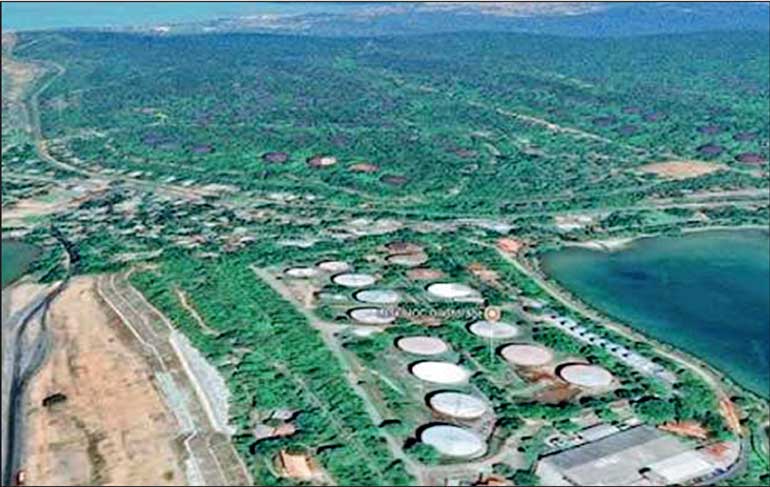Tuesday Apr 22, 2025
Tuesday Apr 22, 2025
Wednesday, 27 October 2021 00:00 - - {{hitsCtrl.values.hits}}

Some of our treasures lying idle have to be and could be used in the right manner with honesty and dignity. A hidden treasure in this instance is the 100 oil tanks farm in Trincomalee
 There is a public brouhaha over the idling oil tank farm in Trincomalee harbour area building up momentum due to many reasons. The rising oil prices with springing fuel shortages now and again, are causing alarm. Conjectures about the country’s inability to place orders in time for oil imports due to acute foreign currency shortages now experienced have exacerbated this situation.
There is a public brouhaha over the idling oil tank farm in Trincomalee harbour area building up momentum due to many reasons. The rising oil prices with springing fuel shortages now and again, are causing alarm. Conjectures about the country’s inability to place orders in time for oil imports due to acute foreign currency shortages now experienced have exacerbated this situation.
Concerns are several. How to get urgent foreign currency requirement and from where? Will this in consequence bring more burdens to the people? What is possible in the short run in this regard? What is ideal as a long term? Is there any way in between? It is worthwhile to examine scraps in our possession left to rust, with no use to any, how to explore possibilities of utilising those fruitfully to the nation?
The Serivanija Jatakaya, dealing with two traders Kakshputa and Serivanija, brings out how hatred and the associated foolhardiness can lead to disaster. It also passingly refers to another hidden truth that some of our treasures lying idle have to be and could be used in the right manner with honesty and dignity. That hidden treasure in this instance is the 100 oil tanks farm in Trincomalee.
When we were under their rule the British decided to make this as their primary logistics station in the east after World War I. They started the oil storage project in 1924 and completed in the late 1930s. Trincomalee harbour is the second deepest natural harbour in the world only second to Sydney, and these 101 oil tanks are spread hidden over a land area bordering the harbour covering 850 acres.
This British built oil tank farm was never used in full capacity after independence and remains only as a monument of the Second World War to date just like the metallic gold pot in the old ladies house (in the Jataka story) lying in the attic of the kitchen unnoticed.
Each of these tanks have a capacity to hold 12,000 tonnes of fuel providing an enormous total capacity of 1.2 million tonnes, much bigger than the capacity of CPC storage facility or even the newly built Muthurajawela complex.
The storage complex fell in to disuse after the British ceded power in 1948 and the nature took over the land. The Government-owned CPC used only 15 tanks in the lower tank farm close to the sea until the farm was handed over to the Indian oil giant IOC in 2002. The IOC too used only these tanks while others were forgotten in the jungales.
Global demand for fuel storage facilities
Above ground tanks are used for crude and refined oil, finished oil products, and natural gas. At retail locations, like gas stations, tanks are stored underground for safety reasons. Tanker ships are used for temporary storage when land storage is at capacity, despite the huge cost as the most expensive option.
The oil-storage trade, is a very important business and they use a market strategy in which large oil companies purchase oil for immediate delivery and storage—when the price of oil is low— and hold it in storage until the price increases. It is a kind of operation similar to hedging with plenty of speculatory opportunities for the investors.
The oil storage business concept started in around 1990s expanded into a fully pledged operation with the involvement of global giants such as Morgan Stanley, Goldman Sachs, and Citicorp—who made sizeable profits by simply sitting on the storage facilities with big investments.
Future demand
The global oil storage market is expected to witness a compound annual growth rate of 5.3% from 2020 to reach 2550.8 million cubic meters by 2027.
The Asia Pacific region too is expected to enter this business with the installation of more upgraded facilities bringing in more opportunities to this market.
Although crude oils vary in density, a good "average" volume-to-weight conversion is 7.33 bbls/mt. Based on this conversion factor, instead of referring to production in terms of e.g. 200,000 bbl/day will indicate it as 27,285 mt/day. Accordingly our capacity for storage is approximately 1.2 million tonnes; which is 1.2x7.33 bbls=8.796 million barrels. Aren’t we sitting on a heap of gold?
Now the question, why?
There is a growing concern over the ownership, utility and available opportunities centred round our oil tank facility.
Trade union movement and the social activities incited by the moves contemplated by the Government in the context of the falling exchange reserves and the limitations likely to be imposed on the imports have started debating the issue.
They are incited to protest and take action solely because they feel it is moral and timely to consider all available options at the time of a crisis. But we have to make an assessment by asking ourselves, what is the most agreeable step that would not lead to further unfavourable consequences?
Minister Gammanpila, forced to bear the brunt for wearing the hat currently, made a recent statement in the Parliament referring to the course of action intended and the historical hurdles that remain imposed which he is trying to surmount. While we are unable to categorically confirm the veracities of some of his revelations, the following are important and worthy of special attention.
1. “Even after the current 35-year agreement ends in 2038, we cannot go with any other investor. We have to go only with India as per the 1987 Accord.”
Now what is this binding clause in the 1987 Indo-Sri Lanka Accord? At least the continuing parliamentarians should clarify this since no copies are available for public perusal! Perhaps Ranil Wickremesinghe, playing the whiz-kid role for the UNP could come forward and clear the air. There are also reports adding to this controversy that according to the 1987 Accord ‘the revival of the Trincomalee oil storage farm and restarting its operations must be implemented by both Sri Lanka and India through a joint venture’.
Now as far as we could see unless India is blocking any move for its development and revival there cannot be any legal impediment to re-open the subject and diplomatically resolve it addressing all issues that may cause concern to India. Fact remains that this is a property that belongs to Sri Lanka under sovereign rights and holds it as a national asset.
According to Minister Gammanpila there is another obstacle overriding this factor and he refers to a subsequent lease deal with the Indian Oil Corporation (IOC) entered into under the Chandrika -Ranil Government in 2003 continuing to be operative till 2038. He has stated that we can develop the Tanks with India and India Only. In his explanation of the matter he further states, “Oil tanks are being denied access since 2003, when Sri Lanka leased out 99 oil tanks to IOC for 35 years, for an annual payment of $ 100,000.”
Again this calls for a closer examination of the said agreement and also warrants an explanation from the surviving parliamentarians of the Chandrika-Ranil regime as to what exactly has transpired.
Madras-based ‘Hindu’ following the Gammanpila statement has reported that, “in an overarching MOU in 2017 on development cooperation, India and Sri Lanka, when the Maithripala Sirisena-Ranil Wickremesinghe administration was in office, agreed to jointly [with LIOC involvement] refurbish the remaining 84 tanks and build related infra-structure in the strategically located Eastern port city. But the two sides were unable to firm up the terms of the project, amid mounting pressure from oil sector trade unions that sought more control for the State-run CPC.”
2. But the Minister has added fuel to the fire by stating that he is revisiting the project on new terms, 'wherein the CPC will retain majority stake in the joint venture. The Hindu further elaborates the minister’s concern, that “LIOC will hold minority share, emphasising that no agreement would be inked before wide public discussions” specially with the Maha Sangha, other religious leaders, nationalist organisations and trade unions.”
Is this approach of the Minister the stand of the Government? If it is so, even if it is not the case, is this approach appropriate? Isn’t it possible to look into a more feasible, amenable diplomatic resolution of the issue? Now our contributions into the subject will be fairly limited due to want of more authentic information. Nevertheless we as outsiders can see several avenues towards an amicable settlement even if the so-called pacts and agreements have led to ambiguities.
One such possibility is to take a look at the global needs, the demands based on such and the opportunity such may provide to mutually benefit overcoming red tapes, legal barriers and any mutual distrusts. If both countries can agree to promote the development with the intervention of a third party (e.g. a large-scale oil producing country) to use our tank farm as a storage facility for their products in the Asia Pacific region, providing the peace of mind to India (with a great concern over any threats to their peace) we can get somewhere close to a profitable deal with surrendering our sovereignty as well as not compromising on India’s fears. Instead of trying to choose a country we can look for an organisation like OPEC or even a giant business conglomerate to come in and join in the venture.
The nitty-gritties are too numerous to be mentioned but the idea conveys an opening to an otherwise complicated issue which may lead to harm diplomatic relations. As it appears that one agreement is pending termination over a period of time (and it is a commercial deal) and the other understandably refers to the need for mutual consensus when engaging in any development such restrictions should not be treated as permanent barriers unsurmountable in a true diplomatic sense.
Discover Kapruka, the leading online shopping platform in Sri Lanka, where you can conveniently send Gifts and Flowers to your loved ones for any event including Valentine ’s Day. Explore a wide range of popular Shopping Categories on Kapruka, including Toys, Groceries, Electronics, Birthday Cakes, Fruits, Chocolates, Flower Bouquets, Clothing, Watches, Lingerie, Gift Sets and Jewellery. Also if you’re interested in selling with Kapruka, Partner Central by Kapruka is the best solution to start with. Moreover, through Kapruka Global Shop, you can also enjoy the convenience of purchasing products from renowned platforms like Amazon and eBay and have them delivered to Sri Lanka.
Discover Kapruka, the leading online shopping platform in Sri Lanka, where you can conveniently send Gifts and Flowers to your loved ones for any event including Valentine ’s Day. Explore a wide range of popular Shopping Categories on Kapruka, including Toys, Groceries, Electronics, Birthday Cakes, Fruits, Chocolates, Flower Bouquets, Clothing, Watches, Lingerie, Gift Sets and Jewellery. Also if you’re interested in selling with Kapruka, Partner Central by Kapruka is the best solution to start with. Moreover, through Kapruka Global Shop, you can also enjoy the convenience of purchasing products from renowned platforms like Amazon and eBay and have them delivered to Sri Lanka.